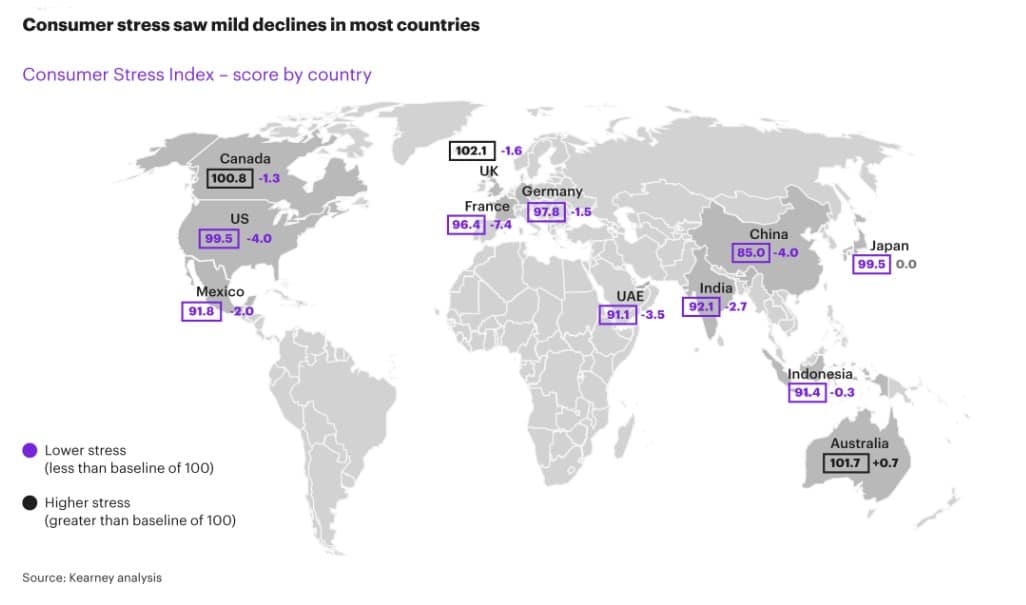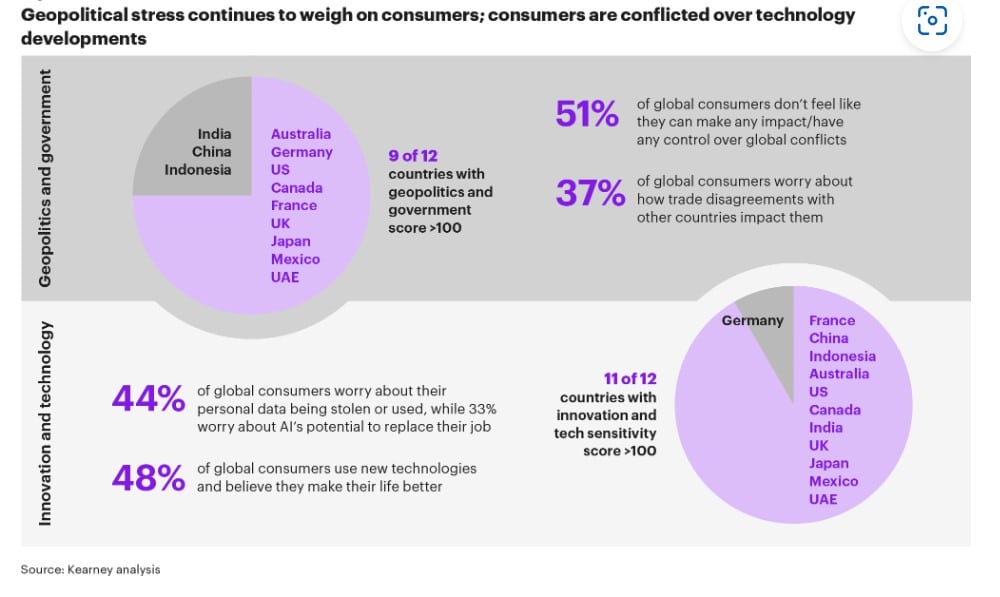What’s stressing consumers out? New research from the Kearney Consumer Institute (KCI) is examining this situation on a quarterly basis. Its inaugural report for Q4 2023 revealed some seriously high stress, which is hardly uncommon for the crazy holiday season. And a new report for Q1 of this year finds that stress levels among global consumers in 10 out of 12 countries studied, including the US, is lower than last quarter—but only slightly so.
The newly released Kearney Consumer Stress Index Q1 2024 Update, based on a unique set of macroeconomic data and consumer input, provides a highly nuanced view of consumer sentiment beyond economics. Data for the report was fielded in March, traditionally a less stressful time for many than the holiday season, which can exacerbate a baseline level of stress across the board. KCI is the internal think tank of strategy and management consultancy Kearney,
“That our Stress Index gauges global consumer stress levels slightly lower than last quarter may seem surprising given ongoing coverage and concerns around food inflation, global conflict, and housing prices,” said KCI lead Katie Thomas, who leads the ongoing research, in a news release. “However, analysis shows that consumers continue to adjust to these recurring challenges, which stabilizes their stress over time.”

The Stress Index tracks multiple components: macroeconomic data, which is updated annually, and consumer sentiment, which is calculated using two elements: consumer flexibility (consumer agency in terms of perceived optionality and ability to impact conditions) and consumer sensitivity or awareness (what issues are top of consumers’ minds and how they are feeling).
“When dealing with consumer behavior, it is critically important to get as complete a picture as possible as there can be lots of anomalies at play,” said Thomas. “For example, we also identify two different forms of stress—the generalized stress people feel as a result of media coverage or peer group interactions, and individualized, personalized stress experienced directly, emotionally, and internally.”
The report found that geopolitics and government has remained a top stressor since the initial index was released in January. Consumers’ sense of agency around political polarization improved slightly, with US consumers in particular expressing more empowerment vis à vis global conflict and national politics. That said, the Index calls for sensitivity and vocalized stress around geopolitics overall to offset much of this reduction.

“The biggest shift this quarter was seen in stress related to innovation and technology,” Thomas added. “As technology evolves, there is constant ‘new news’ keeping the topic top of mind and driving consumer stress. The distinction between generalized stress such as consumers’ broad concerns over AI replacing ‘millions’ of jobs, and personalized anxiety around technological innovation, i.e., ‘my job was just made redundant by a machine,’ shows that while both can cause stress, the level of perceived agency by consumers can differ greatly.”
KCI’s advice for consumer-facing businesses is to avoid messaging that exacerbates politics- or technology-related stress. Additionally, technologies based on what could be seen as radical innovation, or those that require humans to conform their behavior to a machine such as AI, should be introduced carefully to maintain consumer trust.
The Kearney Consumer Stress Index combines proprietary research, surveys, and analytics with publicly available data and reports, weighing and balancing macroeconomic factors, consumer flexibility, and consumer sensitivity. Macroeconomic sources comprise 50 data points organized into five pillars—consumer wallet and finances, health and education, geopolitics and government, food and the environment, and innovation and technology—across 15 sub-categories. Both the consumer flexibility and consumer sensitivity sections use proprietary consumer surveys as their primary input, with more than 18,000 global consumers surveyed (1,500 respondents in each of 12 countries).








